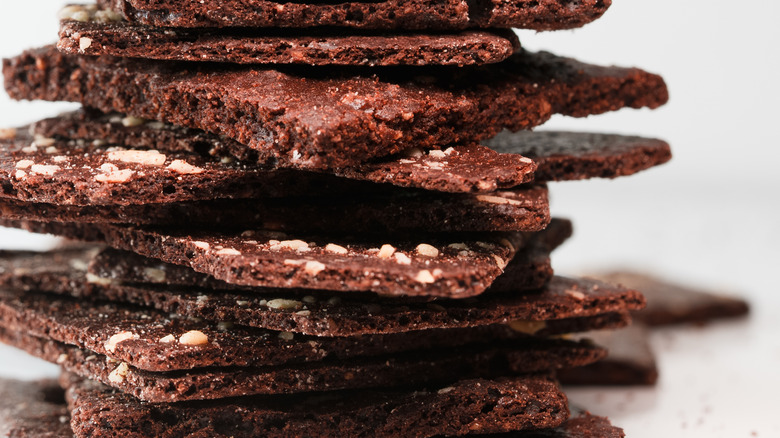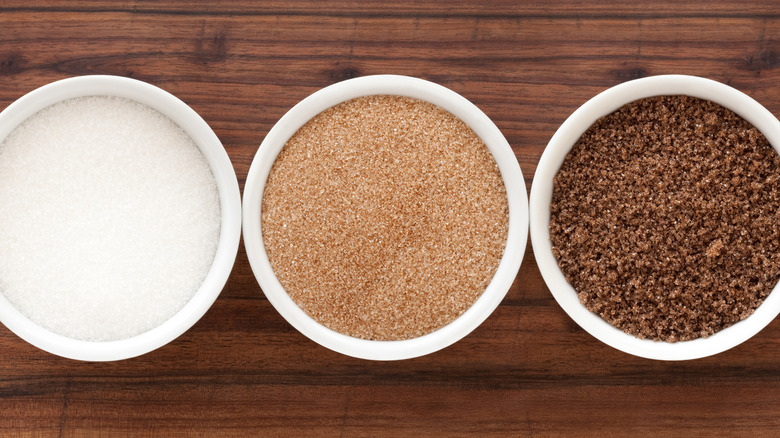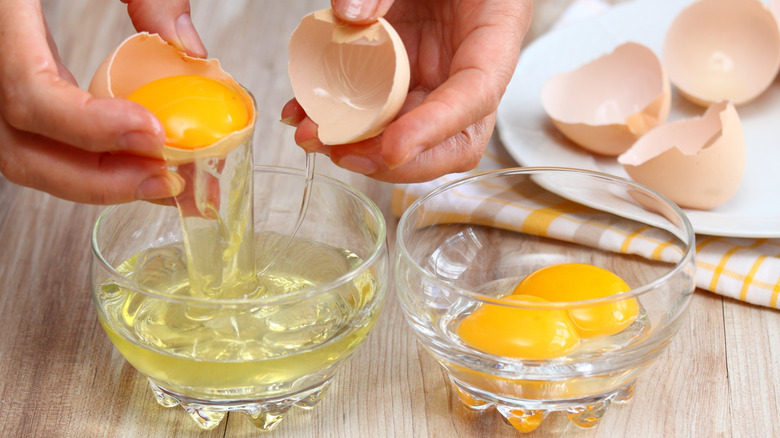The Ingredient Swaps You Need For A Delectable Brownie Brittle
Baking is chemistry, and the exact balance of a recipe's ingredients can make or break it. Swapping ingredients for substitutions can unwittingly cause a disaster if you're not careful. But what if you're trying to break it? It's possible that your existing brownie recipe just needs some tweaks to become the brownie brittle of your dreams.
A longtime favorite treat of Costco shoppers, Sheila G's brownie brittle isn't your only option; with a couple of key ingredient swaps, you can make your own at home. Brownie brittle is, in essence, the crispiest part of a brownie without any of the fudgy parts. With substitutions — namely, white sugar for brown sugar and egg whites for whole eggs or egg yolks — you're on your way to optimizing crispiness.
Experimenting with a few batches of brittle will tell you how far to go with an ingredient substitution; exchanging 100% of the ingredient versus 50% or 66% will depend on your personal preference for the finished product. Keep fiddling with your recipe until it's just right. No one was ever upset to be a brownie brittle taste-tester, after all.
Why swap brown sugar with white sugar?
Not every brownie recipe will call for brown sugar, but if yours does and you're trying to build your perfect brownie brittle, this should be the first substitution. Chemically, sugar doesn't just sweeten baked goods; it also helps them retain moisture — even granulated sugar, which has about 10% less moisture than brown sugar to begin with.
When cane sugar is being made, sugar cane is harvested, washed, shredded, and crushed. The extracted liquid then gets filtered and evaporated; as it is reduced and cooled, it is seeded with grains of existing sugar, which causes the crystals in the new batch to form. After this liquid is drained (this is molasses) to separate the crystals, this is brown sugar. It still has surface molasses, which is where the additional moisture comes from. To create white sugar, the brown sugar gets rinsed and dried, ridding it of the moist molasses.
So what does this mean for your brownie brittle? Swapping out brown sugar in favor of granulated white sugar will reduce the moisture in your batter. The less moisture in your brownie brittle batter, the more crisp it will turn out.
Why swap egg whites in for whole eggs?
Eggs are basically three components, excluding the shell: Protein, water, and fat. Eggs are used in baking to provide binding and structure, but egg yolks also add density through their fat content. The egg yolk contains all of an egg's fat; this is why adding extra egg yolks to recipes generally makes them more decadent; you're increasing the protein-laden fat. By omitting the yolk, you're reducing the fat in the recipe, making it leaner and less fudgy.
If you like truly shatteringly crisp brownie brittle, you might want to try replacing all the eggs with egg whites. If you like to have a little bit of chewiness along with your crispiness, you might like a different ratio. Try replacing half the eggs with egg whites, or try two egg whites to one whole egg if your recipe calls for three eggs.
It's important to note that because egg whites contain the majority of an egg's water content (about 66%), a recipe that only uses egg yolks or uses a majority of egg yolks will be a wetter batter than one that uses whole eggs — you're introducing more water by switching to egg whites. You may need to adjust your cooking temp or time to account for this. Most brownie recipes call for whole eggs, though, and this substitution won't increase the moisture at all; in fact, it will decrease it ever so slightly, making a delectably crisp brittle.


